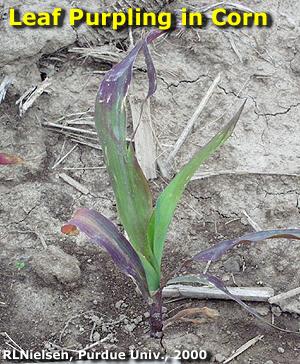![]() ick your colors.......... Yellow, Purple, Red, and even
White. These are the colors that many corn growers are seeing as they walk
their corn fields this spring. Given the growing season to date, multi-colored
corn is not unexpected. Here’s why.
ick your colors.......... Yellow, Purple, Red, and even
White. These are the colors that many corn growers are seeing as they walk
their corn fields this spring. Given the growing season to date, multi-colored
corn is not unexpected. Here’s why.
As Mother Nature often reminds us, corn grows and develops best with sunny days and warm temperatures. Indiana has simply not had many days like that so far in the 2000 growing season. Couple that with the fact that a sizeable percentage of Indiana’s corn crop was planted on the early side back in early to mid-April when temperatures were even cooler and it is no wonder that many fields are an ugly yellow-green rather than the darker green that we would prefer to see. Warm, sunny days will correct this.
 Purpling results from the accumulation of a purple pigment called
anthocyanin. Whether or not a corn plant produces anthocyanin is
determined by the hybrid's genetics. Some hybrids contain more
‘purpling’ genes than others.
Purpling results from the accumulation of a purple pigment called
anthocyanin. Whether or not a corn plant produces anthocyanin is
determined by the hybrid's genetics. Some hybrids contain more
‘purpling’ genes than others.
Purple corn is caused by one of two factors. The first factor is simply a genetic response to cool nights following bright, sunny days. Warmer weather will cause the purpling to slowly disappear.
The second factor is restricted root development, coupled with an abundance of plant sugars produced by photosynthesis that triggers the purpling. If the cause of the root restriction is temporary (e.g., cool temperatures), then the purpling should disappear as the plants develop further and yield losses should be minimal, if any. If the cause of the root restriction continues to affect plant growth for some time (e.g., soil compaction, grub feeding), then the purpling may continue for some time and some yield loss may result if the plants become stunted.
Remember that the effects of early season damage to the seed or root system can be magnified when corn is already developing slowly due to cool, cloudy weather.
White corn historically was often blamed on the herbicide clomazone (e.g., Command), but can also be caused injury by the herbicide isoxaflutole (e.g., Balance) and by spray drift of glyphosate (e.g., Roundup). Single white plants in a field are usually genetic mutants.